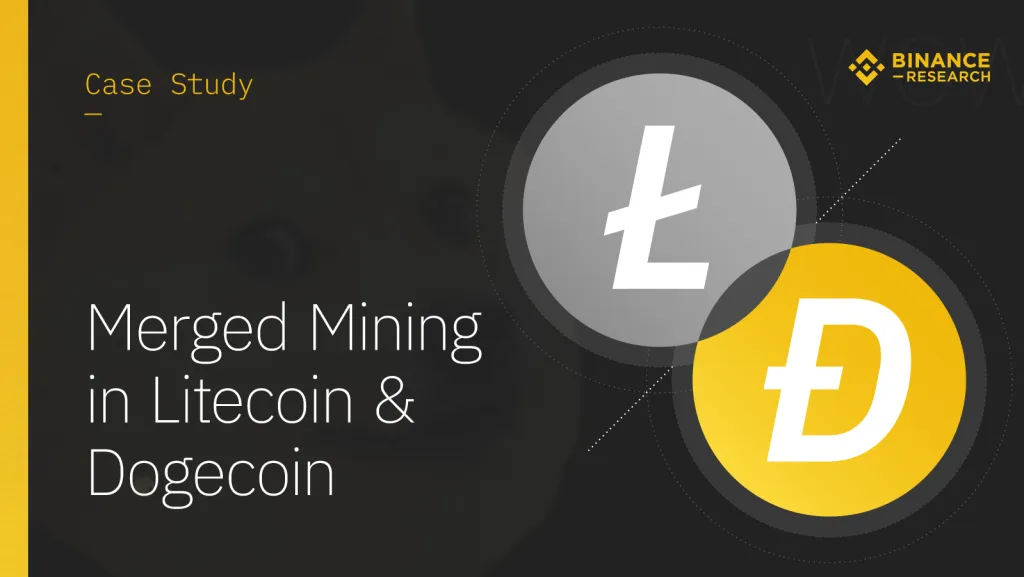In a case study by Binance Research, the company shows how miners can improve profit margins with altcoin mining. Merged Mining is the process of bringing together multiple users of a blockchain. This increases the chance of successful block additions and in turn higher profits. Merged Mining crypto profits can be used to offset halving event losses.
The case study looked at the possibility of using the Dogecoin (DOGE) strategy of merged mining on the Litecoin (LTC) blockchain. The merging of effort improves the possibility of successful block addition.
Binance Research, the market research and analysis arm of Binance, has released a new case study report on whether merged mining, which is practiced by Dogecoin (DOGE) on the Litecoin (LTC) blockchain, provides increased security for smaller Proof of Work (PoW) blockchains.
HALVING FEARS
Bitcoin and Litecoin go through halving events. These events are built into the system and are triggered with a certain target is achieved. In this case, the amount of tokens miners get per block added keeps halving the more the network becomes mainstream. This was made to ensure the possibility of moving out of the miner paradigm.
Miners have been hit by this. More people mining reduces the chance of successful block addition. The network needs complex and high end hardware to complete the Proof of Work. With the halving event, mining may not provide any profits.
Merged Mining could increase crypto profits and security.
HOW IT WORKS?
Merged mining refers to the use of the work done for one blockchain (i.e. parent blockchain) on other smaller child blockchains, using Auxiliary Proof of Work (AuxPoW). In the report titled “Case Study: Merged Mining in Dogecoin & Litecoin,” Binance Research studied the merged mining relationship between Dogecoin and its parent blockchain Litecoin, two of the longest-standing cryptocurrencies, each registering around 30,000 daily on-chain transactions.
“Given that block mining rewards are halved every four years for both Litecoin and Bitcoin, merge-mining could potentially become a solution to maintain network security in the long-run as newer cryptoassets, with higher block rewards, could be merge-mined within the same pools,” Binance Research noted.
Since Dogecoin’s switch to AuxPoW in 2014, Dogecoin’s hashrate has exhibited an extremely strong and positive correlation (0.95) with Litecoin’s hashrate, according to findings by Binance Research. As of July 2019, nearly 90% of Dogecoin’s total hashrate comes from large Litecoin mining pools, with its blockchain processing around 30,000 transactions per day.
PoW vs PoS
Binance Research pointed out that PoW as a consensus mechanism component has recently lost popularity in favor of Proof of Stake (PoS) consensus mechanisms for a variety of reasons, including but not limited to high mining costs and environmental impacts. Other smaller chains could potentially move to AuxPoW in the coming years in order to maintain greater network security while reducing the need for a seperate miner set. Merged Mining could increase crypto profits.
“While greater network security is the main purpose for implementing merged mining, there are also potential disadvantages and risks to consider for both miners and the blockchain itself,” Binance Research said in the report. “Specifically, the value proposition of the underlying cryptoasset needs to be compelling enough to attract a critical mass of miners to switch their current mining set-up to a new one that supports merged mining.”
WHAT IS BINANCE RESEARCH?
Binance Research provides professional, data-driven insights and analysis for investors in the crypto space to increase the level of transparency and improve the quality of information within the current crypto ecosystem. The team consists of professionals with a background and experiences in blockchain engineering, investment banking, strategy consulting, academic research and data science. For more information, click here.



